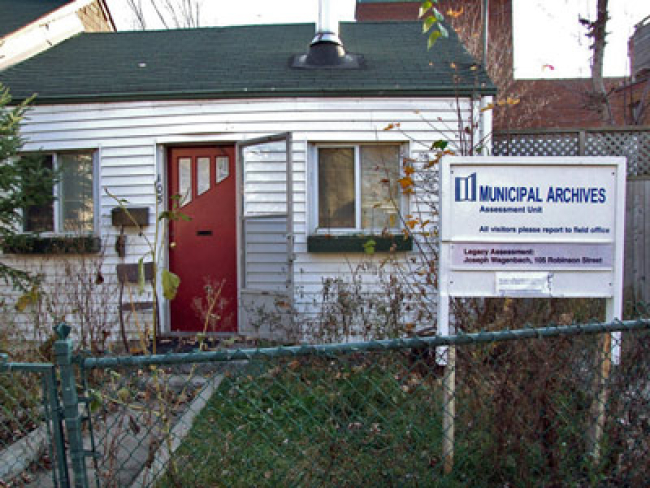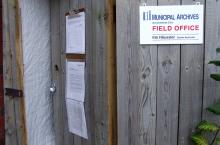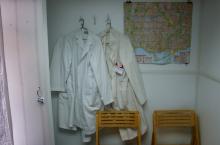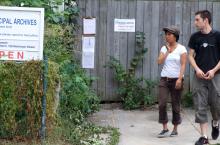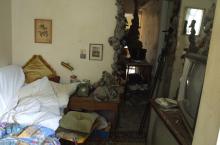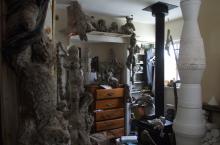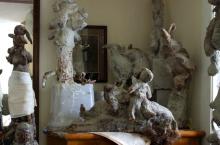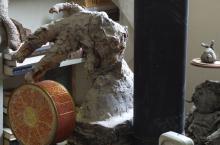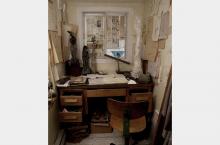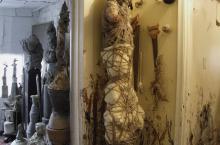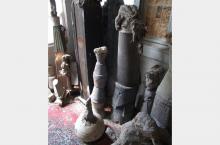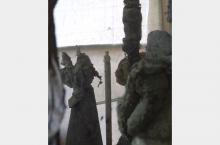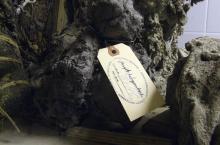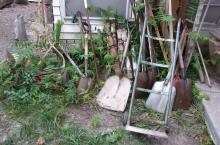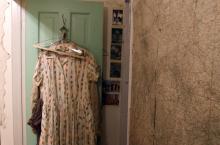Narrative Tour
We sign a waiver that reads like the disclaimer to a jungle survival camp and don white lab-coats before the courteous archivist escorts us into a secluded house just off Queen Street West. Stale air. Dim light filters through layers of newsprint and grime that obscure the windows. An old sofa emerges, a phone that can't receive calls, aged photographs. A narrow path through household clutter ends at an armchair before a wood stove. Familiar icons of old age, were it not for the sculptures...
(text continues after gallery...)
Emerging from the walls, stacked on racks and rising from pedestals everywhere, the small rooms are packed with a veritable pandemonium of amorphous, organic form. Brown layers of wax sculpt human and animal chimeras; one can identify rabbits, doll fragments, perhaps teddy bears. They rest on shelves, huddle in corners as if murmuring to each other, dusted with cement. Who lived here? What caused him to transform his space in this consuming manner? A derelict coffee-cup seems to have dried out just a moment ago. As we brush against hanging figures that block the passage, or squeeze past bulging coats in a claustrophobic hallway, we appreciate the lab-coat's reassuring barrier. Room after room unfolds, each different and surprising, beckoning us to browse, examine, discover and physically immerse ourselves.
Iris Haeussler, a Toronto-based artist and recent immigrant from Germany, has constructed the life of a person seemingly obsessed with sculpture in this small house. On one level, we are confronted with a fictional, psychological narrative of an old man's memories, defined by the history of the early 20th century and set in the unique context of immigration and identity in Toronto. But on the other hand, the house really exists, the sculptures are real, the atmosphere and spaces combine to an unsettlingly detailed reconstruction of the art and artefacts of decades. And in our mind, Wagenbach, the old recluse, becomes present and tangible. One understands why the archivist knocks before she enters.
A sectioned column transcends the house, anchored in a kind of cellar-space and pierces the ceiling into the attic. We are reminded of Constantin Brancusi. Indeed, the archivist replies, we have reason to believe Wagenbach may have met the famous sculptor in Paris. So was he himself an artist then? Or was he just an eccentric? "We are still assessing" is the archivist's answer to many of our questions.
Wagenbach's work displays a lifetime of changing styles and subjects. Classical nudes neighbour constructivist cylinders, stacks of sketches adjoin splashed traces of vivid, physical labour. The later works appear troubled, they evoke an impresion of art as the principal outlet for some unspeakable personal history. Wagenbach may have produced sculptures in a search for resolution, if not absolution, by re-enacting impressions of shape and form; never quite enough though, and increasingly frantic as the surrogates failed to provide closure and life draws to its end.
Seamlessly crossing between fiction and reality, narrative and history, theatre, sculpture and prose, Haeussler takes us on a deeply touching journey. As we leave, we can't help but cast a curious glance at the neighbour's drawn curtains.
[N.B.]

